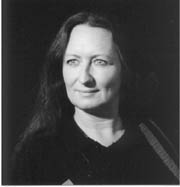|
|
|
Herbal
Help for Women's Cycles
by Victoria G. Fortner • Overland, MO
It’s long been a joke among women that if men had PMS, cramps
or hot flashes, a cure would have been found for it years ago. The truth
is, there has been a cure for it all along. In the past century, Americans
especially have grown to disdain those things that smacked of the "old
knowledge." Science and technology have moved to the forefront. Only
since science "discovered" the life-giving plants of the rapidly
diminishing rain forests and other natural places have the potential and
properties of herbs regained recognition. As for indigenous Native Americans,
we have held the wisdom of our plant relations in common and sacred knowledge
for eons. Plants are seen as viable and participating members of our world.
Without the support of the other "nations," we as human beings
would not exist.
The gifts of the “Green Nations” are not small. To start with,
70% of our food base is agricultural. Over 75% of all pharmaceuticals
were originally derived from phytochemicals and over 36% of all drugs
used for cancer come from the rain forests. That last figure is pretty
scary when you remember that the forests are being destroyed to the tune
of one football field sized area every 15 minutes. Total destruction.
Total ruin. Totally unacceptable. Until humankind manages to paint itself
into a corner and run out of botanical options, let’s look at how
herbs can help stop the monthly suffering of women.
Most familiar to many is licorice. Although we usually think of it in
connection with candy and as a flavoring, licorice root is an antispasmodic.
It acts like estrogen in the system and it is also an anti-inflammatory.
These are three important functions when dealing with PMS and menstrual
cramps. Pleasant tasting and sweet, the root itself can be chewed or taken
in tincture or capsule form. However, care and caution should be used
by women facing reproductive cancer, especially after surgery. In some
forms of cancer, an increase in estrogen can cause different tissues (cysts,
tumors, etc.) to grow rapidly. Contact your doctor about estrogen supplements.
Saw palmetto (a small palm growing in southeastern North America)
is also an anti-inflammatory, but has the added bonus of decreasing ovarian
irritability. Suma (a South American herb) is a wonderful immuno-modulator
(it supports and boosts the immune system.) This root energizes the body
and combats anemia, fatigue and stress. Mitchella repens is commonly
known as "squaw vine,” but it will not be referred to in that
way here. "Squaw" is a derogatory term which has been bastardized
from its original Native form. It refers to a woman’s genitals. This
uterine tonic has been used throughout history to help prevent miscarriage.
Gotu Kola, known in tropical countries and in Ayruvedic medicine,
promotes healing after childbirth and aids in eliminating excess fluids.
It acts as a nerve tonic, decreases fatigue and depression and is said
to help the sex drive. Wild Yam is a misunderstood herb which is
often referred to as a phytoestrogen, but that may well be erroneous.
My experience with it is that it helps stabilize hormone levels but is
not a phytohormone itself.
Dong Qui (also known as Dang Gui and Tang Kuei) is
an amazing general tonic. This herb, also an anti-inflammatory and anti-spasmodic,
aids women of all ages by helping regulate menses and stopping cramps,
insomnia, hypertension and hot flashes. Schizandra fruit, also
from China, is a friend to women entering the Grandmother Lodge.
This herb is an anti-depressant. It is a mild stimulant that lowers blood
pressure and stops night sweats, heart palpitations and insomnia.
Vitex, or Chaste berry, is helpful to women through modulating
progesterone levels relative to estrogen and reducing hot flashes and
PMS. Soy (as in beans, tofu, tempeh and soy milk) is an antioxidant
and contains isoflavinoids which lower the risk of breast cancer, reduce
hot flashes and boost the immune system. Red clover, like soy,
contains isoflavinoids and is a phytoestrogen. It has many of the same
effects as soy.
Most of these herbs can be found in health food stores in capsules or
tinctures. However, the best and most successful applications of these
herbs are in combination. While there are many herb companies making and
promoting women’s herbal support, know that each woman is different.
While one product may do little for you, another may be exactly what you
need. Likewise, be prepared to try one for a month or two before you make
up your mind that it is or is not what you want. Certain herbs work better
in concert with others, and only a well-trained herbalist can help you
decide what is best in your particular case.
Victoria G. Fortner, or PeatohahNape Tamsah, is trained in both allopathic
and Traditional Indigenous medicine. She owns Shawnee Moon Herbaceuticals.
For info, send SASE to Shawnee Moon Herbs, PO Box 142682, Overland, MO.
63114-0682 or visit their website at: www.shawneemoon.com.
|

